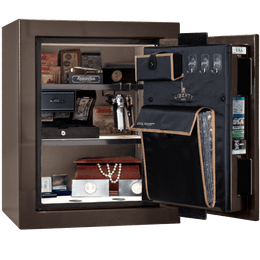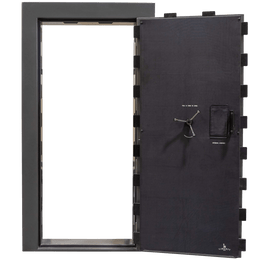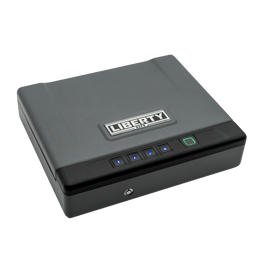People have been mounting scopes to hunting-style handguns since at least the 1950s, and the first pistol-mounted red-dot optics appeared around 1990. For a couple of decades, handguns with red-dot style optical sights were virtually unknown outside of Bullseye, IPSC, or other handgun competition settings, but that began to change quickly in 2009 with Trijicon’s launch of the original RMR (Ruggedized Miniature Reflex) sight. Today, nearly every popular duty- or CCW-type handgun is offered from the factory with provisions for mounting a micro red-dot optic to the slide. All major competitive shooting organizations have created new divisions or classes to allow firearms with red-dot optics to compete with each other, since using these optics generally improves speed and accuracy across the board. We’ve previously written about some of the most popular types and models of mini red-dot optics, but several exciting developments and new offerings have emerged over the past couple of years that warrant an update.
Let’s look at some of the recent advances in handgun red-dot optics, go over their pros and cons, and help you make an informed decision should you want to try one.
Aimpoint COA
In January 2025 Aimpoint released their new COA enclosed-emitter optic developed in collaboration with Glock. The Swedish firm Aimpoint invented the red dot concept in the mid-1970s, and have been instrumental in getting red dot and other electronic optics accepted as mainstream equipment by the world’s militaries and police forces ever since. This new offering is a quality, fully enclosed red dot similar to Aimpoint's ACRO P2, but with a much slimmer housing, improved controls and electronics, and an innovative mounting system that has the potential to become a new industry standard.
Aimpoint and Glock worked together to develop the new A-CUT mounting system, which sidesteps all the fiddling with screw patterns and recoil bosses and instead uses a wedge or dovetail design. The nose of the optic has a full-width protuberance along the bottom, and this lip inserts into and under a similar-shaped dovetail cut in the top of the Glock’s slide. Some have described it as being similar to how a ski boot fits into alpine ski bindings. The side-to-side movement of the optic is restricted by long, lengthwise surfaces milled into the top of the slide, with matching profiles milled into the bottom of the COA. At the rear, once you toe-in the front of the optic and drop it fully into place, there’s another wedge-shaped surface in the slide, and a matching angle on the bottom of the COA. However, a separate wedge keeper is then placed above the rear lip of the COA, and this keeper is secured with two screws. Aimpoint says this system is designed and tested to survive at least 40,000 rounds without breakage.
So, what’s so special about the COA and the new A-CUT? Well, since there are no screws penetrating through the optic housing and into the pistol’s slide, there’s no lateral force exerted on those screws, which greatly improves durability. The two rear wedge retention screws have no shear forces applied to them at all… they simply secure the wedge, which applies angular force forward and down against the body of the optic, pressing it into its recess. The dedicated A-CUT also allows the user to co-witness the standard Glock front sight (in combination with the OEM-height rear sight milled into the COA’s retention wedge), through the bottom of the COA’s viewing window. The optic sits exceptionally low. This also helps shooters acquire the red dot in the window more intuitively, since it’s closer to where you naturally align your sights when using the standard iron sights.
The CR2032 battery lasts for 50,000 hours (over 5 years) on brightness setting 7, and is secured in a side-mounted tray which is retained by a screw for extra security. There are 12 brightness settings controlled by large, intuitive up-down buttons on the left side of the COA. These auto-lock to prevent contact with the body or holster during concealed carry from turning off the dot. So, the first time you push either the up or down button, it unlocks the controls, and if you don’t push it again within 3 seconds, the system re-locks. What this means is that you just have to push the button twice to start changing the brightness. This is a very simple solution to a real potential issue. Additionally, if left above setting 9, including in the ultra-bright setting 12, there’s a 2-hour timer that automatically drops the brightness by one level (from 12 to 11, 11 to 10, etc.) if the user doesn’t manually set the brightness to that level again. This prevents battery drain while still maintaining a useful brightness level for nearly all situations.
For the first 12 months after release, the COA is exclusively available as a package with one of the compatible Glock models (G19, G45, G47, G48, G43x), and isn’t sold separately. Aimpoint will certainly share the details of their new A-CUT dimensions with other manufacturers, who may or may not want to change up their mounting systems. However, with the advantages and ease of installation provided by the A-CUT, we’re guessing it has the chance to make some inroads with other manufacturers.
MSRP for the Aimpoint COA/Glock packages ranges from $1,002 (for the G48 and G43X) to $1,165 (for the G19, G45, and G47). Remember, that includes the Glock pistol, which carries a retail price of up to $707. Pretty solid deal, in our view, and we’re confident prices will come down over the coming months.
Trijicon RMR HD, RMRcc, SRO, and RCR
Although there were other micro-sized red-dot optics on the market before the Trijicon RMR ($742 MSRP) launched in 2009, the RMR has earned its reputation as the most durable, reliable micro-red dot in multiple rounds of extreme-environment testing by government and private entities. The RMR has been adopted as USSOCOM’s official handgun red dot sight, and is used by multiple police and special tactics units across the globe. The RMR mounting footprint is effectively the industry-standard pattern, and almost every duty-sized pistol with optics mounts is either milled for a direct-mount RMR installation, or includes pins or plates allowing its use. However, technology advances and market requests have led to some innovative upgrades or variations of the proven RMR optical sight. Let’s look at what makes these new products noteworthy, and why you might select one over the original RMR.
RMR HD
Trijicon’s RMR HD ($1,019 MSRP) was announced in 2023 and hit the market mid-2024, with several significant upgrades compared to the original, well-loved RMR. The most obvious change is a larger, more forward-mounted window, with a somewhat similar profile to the SRO (see below) but retaining the original RMR’s impact-resistant owl-ears shape for maximum protection against drops and impacts to the optic. Trijicon has added a molded-in central indexing line on the top of the HD’s housing, in the rare event your dot goes down or becomes occluded. The HD also gets a top-mounted battery compartment, which is a welcome change for RMR users who get tired of dismounting their optics every year or two to replace the battery, then reapplying threadlocker and re-zeroing their firearms. Water-resistance isn’t impacted, as the HD shares the original RMR’s 20-meter waterproof rating.
Other improvements include a forward-looking light sensor for more effective auto-brightness settings, larger, more tactile and audible function buttons, improved detent clicks on the zeroing screws, and new combination reticle that allows you to switch between a 55 MOA segmented circle reticle (similar to an EOTech reticle) and a central red dot (either 3.25 MOA or 1 MOA), both of which are independently adjustable for brightness. Both reticles get a new super-bright setting and an additional night vision setting for those using NODs. The RMR HD also allows you to selectively lock out the auto adjust as well as the side buttons, so you can ensure your duty/carry pistol optic will be in the exact brightness setting you want when you need it.
Trijicon says the RMR HD will fit duty holsters designed for guns using the RMR, and in some cases, that’s accurate. However, if your holster includes an integral optics cover that fits over the standard RMR, or if your holster covers the top of your pistol up to where it’s nearly touching the RMR’s front face, you may find the HD’s forward-set lens housing causes interference and requires a different holster. The larger window, improved settings, and new reticle options may make it worth the switch. On the other hand, if concealment is your primary concern, the original RMR (or the RMRcc; see below) is certainly a little less bulky, though their lenses and housings are smaller.
SRO
Trijicon’s SRO (Specialized Reflex Optic; $783 MSRP) launched in 2019 and was the first variation of the basic RMR pattern offered by the company. Unlike the original RMR, which was initially intended for mounting on rifles as a backup for primary magnified optics, the SRO was designed specifically for use on handguns. The SRO uses the same mounting footprint as the RMR, but features a larger, rounder window with an extended housing made of 7075 aluminum. Many shooters prefer a round viewing window, and a larger window makes it much easier to track the movement of the dot throughout the firing sequence compared to a smaller window. The downside of this thinner, larger, and round-shaped lens housing is that the optic is objectively less durable and resistant to severe impacts than the original RMR. While it features a much-more convenient top-mounted battery compartment compared to the original, this (combined with the different construction of the SRO) means that the SRO is waterproof only down to 3 meters, while the original RMR, with its less-convenient under-housing battery access, is waterproof to 20 meters.
For 95% of competition shooters and likely the majority of CCW pistol owners, the issue of a handgun optic surviving extreme impacts isn’t a priority, and they will favor the SRO’s larger window, intuitive circular lens profile, and easy top-mount battery configuration. For combat or duty use, the original RMR or the new RMR HD are more demonstrably more durable and resistant to serious impacts, with the tradeoff in price and a visually bulkier lens housing.
RMRcc
The concealed-carry oriented RMRcc ($699 MSRP) was launched in late 2020, and is essentially a scaled-down version of the original RMR. The RMRcc is 0.9” wide and 0.9” tall, which is 2 tenths narrower and one tenth shorter top to bottom than the original. This might not seem like a lot, but it fits a lot better on the super-slim micro-compact 9mm pistols, the majority of which have slides less than an inch wide. There are well-thought-out brightness adjustment buttons on either side of the main housing (8 brightness settings, including 1 super bright mode and 2 night vision modes), and you can also lock-out auto-brightness (if you want the optic to remain at your specified brightness level), or lock-in auto-brightness (which prevents the buttons from dimming or brightening the dot too much unintentionally). Like the original RMR, the RMRcc’s CR2032 under-housing battery installation requires you to remove the optic every year or two to replace the battery, but many people prefer the bomb-proof ruggedness this design facilitates. Like its full-size RMR brother, the RMRcc is waterproof down to 20 meters.
If you’re used to shooting a handgun equipped with a standard RMR optic, the RMRcc will be an easy transition, and you may not even notice the slightly smaller window of the RMRcc. There are people who prefer the smaller overall size of the CC version and use it even on their full-sized pistols. Just about the only thing we don’t love about the RMRcc is that it utilizes its own, proprietary mounting footprint, rather than the Shield RMS-c pattern (which is effectively the industry default footprint for the tiniest red dots). This is also one contributing factor to the RMRcc not being a particularly hot seller among the super-micro red dots on the market… in addition to its not-insignificant price. However, if you’re a fan of the brand or the specific model, you can have your pistol milled specifically for the RMRcc (including the famously slim 1911 slide), or simply use one of the widely available adapter plates that allow the use of any optic you prefer.
RCR
Trijicon announced the release of its new RCR (Ruggedized Closed Reflex; $1,019 MSRP) sight in the summer of 2023. The secret sauce behind the RCR is that unlike the other Trijicon RMR-based sights we’ve mentioned so far, the RCR is an enclosed-emitter design, with both a front and rear lens encased in a full-coverage 7075-T6 aluminum housing that has proven just as durable as the original RMR. So what’s the big deal about an enclosed-emitter optic? Well, similar to a rifle scope, a holographic rifle optic (like an EOTech) or a traditional tube-type red dot optic like the Aimpoint T2, an enclosed-emitter red dot is not affected by moisture, dirt, snow, lint, or water droplets getting close to the emitter. The rear lens and housing seal the optic watertight, and the interior is purged with nitrogen or argon to prevent condensation or fogging when changing environments or temperatures. If you get mud or snow or Twinkie frosting on the rear lens, you simply wipe it off with your finger and you’re off to the races.
Also, even though the rear lens and housing covers up the original mounting screw locations from above, Trijicon came up with an innovative side-torquing Capstan screw setup for the RCR so it can use the original RMR footprint. The optic includes threadlocker and a Capstan hex torque guide, resulting in an easy mounting solution that prevents over-torquing, cross-threading, or stripping out of the included screws. Two screw lengths are included, for FN and non-FN pistols.
The issue of either behind-the-lens battery compartment (like the SRO or RMR HD) or under-housing battery compartment (like the RMR and RMRcc) has been solved by a top-mounted CR2032 battery arrangement, whose cap is protected by the RMR-style owl-ear shaped housing. Battery life is 6 years of continuous operation at brightness setting 5, but we’d swap out the battery every year just for peace of mind, especially since it’s now so easy to do.
Another feature of the RCR is the deck height, or the top of the lower section visible through the optic, is identical to the RMR. So handguns set up with iron sight arrangements that permit co-witnessing through the RMR will also co-witness through the RCR.
Bonus: Like all Trijicon red-dot optics, the RCR is 100% made in the USA. Hoo-rah!
SIG Romeo-X Enclosed, ROMEO2, ROMEO3MAX-PRO
SIG SAUER is knocking it out of the park with a bunch of exciting new optics models over the past couple of years. Let’s look at 3 of our favorites.
ROMEO 2
One of the most innovative (and potentially a clever answer to a question nobody asked) is the ROMEO2, which is a unique hybrid open- and closed-emitter pistol optic. The basic optic is a good-quality, open-emitter style red dot featuring a choice of 3 reticles, to which you can then add a steel half-shroud for additional impact production if you so choose.
But wait, there’s more! (As the great Ron Popeil often said.) If you want the additional emitter protection afforded by an enclosed-emitter optic, you can add the included polycarbonate rear lens, and screw on the fully enclosed steel shroud over the whole affair. It’s a little gimmicky, but definitely innovative, and we could see how it could be useful for some customers. Another kind of cool feature is MAGNETAC, which means that the front of the optic is sensitive to a magnet enclosed either in the optic cover or a MAGNETAC-compatible holster, which turns off the optic when it’s not in use. This is very useful for duty carry and police use where a shake-awake/motion sensitive optic (which the Romeo 2 is) would essentially be left on all the time. With MAGNETAC, you can be more confident that your duty optic’s battery won’t be discharged when you draw your pistol. The Romeo 2 retails for $599-$699 MSRP depending on whether you want a half-shroud or just the open and fully shrouded options.
Romeo-X Enclosed
The really hot trend the past year or so has been toward fully enclosed emitters, since there’s basically no downside other than cost and perhaps a little bulk. SIG offers some super-expensive enclosed-emitter optics intended for use on their military M17/M18 pistol contracts, but for most of us, the new Romeo-X Enclosed optic ($479 MSRP) is going to be the one grabbing our attention.
Launched mid-2024, this new optic is offered in either the Compact (RMS-c footprint) or the Pro (DeltaPoint Pro footprint) size, with direct-mount capability on SIG’s P365 (in Compact) or P320 (Pro) lines of pistols… or any other brand using the same size footprints. The deck height of these optics is ridiculously low when mounted directly to the slide, allowing co-witnessing with even standard-height iron sights. Additionally, the rear of the Romeo-X Enclosed models contain an integral rear sight that makes it even easier to align with the front and can help you find the dot quicker if you’re not well-practiced with that.
Like the Romeo 2, the Romeo-X features SIG’s MOTAC motion-activated illumination, which extends the already impressive 20,000-hour battery life by shutting down the reticle if the optic isn’t moved for approximately 2 minutes. As soon as you move the optic/gun at all, the reticle instantly turns back on. The Compact variant of the Romeo-X Enclosed is essentially the same size as Holosun’s Excellent EPS Carry optic, though we’ve found that SIG’s glass is clearer, the dot is crisper, and the SIG doesn’t reflect ghost images of the emitter up onto the lens when looking into sunrise or sunset skies. The multiple brightness settings, guarded controls, side-mounted battery, and other features are intuitive and very useful. Overall, the Romeo-X Enclosed is one of the most impressive pistol optics we’ve used over the past several years, and we feel it’s well worth the price.
SIG is making a big deal out of these optics being assembled in the USA, which is a good thing. Another thing you may not be aware of is that since the M17 optics are part of the NATO supply chain, by law they can’t rely on America’s political enemies for any components. So if you want a pistol optic that doesn’t put money into the pocket of countries working toward America’s downfall, SIG’s line is a solid choice. And the prices are attractive considering the excellent glass quality of SIG’s recent optics offerings.
ROMEO 3 MAX PRO
In this case Max stands both for Maximum awesomeness and refers to Team SIG Captain and 7-time World Speed Shooting Champion, Max Michel, who helped develop this new competition-oriented red dot. Unlike the previous ROMEO3, the ROMEO3MAX is a direct-mount to the DeltaPoint Pro footprint and doesn’t require an adapter plate. This means the deck height is lower and you can cowitness with suppressor-height sights. You can choose from 3 MOA or 8 MOA dot versions, both with a huge, 31mm glass aspheric lens with red notch reflector coating for excellent light transmittance, reticle brightness, and zero distortion. There are 15 brightness settings for rapid target engagement under a full range of lighting conditions. Like the other SIG optics, the ROMEO3MAX gets SIG’s MOTAC motion-activated system that powers up when it senses motion and powers down when it does not. You also get the MAGNETAC (Magnetic Activation) feature that turns the optic off when using the included rubber optic cover, for preserving battery life even more between match stages or when storing/transporting the optic.
The side-mounted CR1632 battery tray is double-secure with slotted screws, and provides a 20,000 hour runtime at medium brightness settings.
Another feature we love about SIG’s new line of optics, apart from their being assembled in the USA from NATO-partner-sourced components, is that they all come with SIG’s Electro-Optics Infinite Guarantee: They’re backed by an unlimited lifetime guarantee. Yep, you read that right.
Holosun SCS Carry
Holosun’s Chinese-American business model has led to a significant shakeup in the firearms optics market over the past decade. The company has rapidly innovated, forcing competitors to step up their game, and for the past few years, Holosun’s 507 and 509 series of handgun optics has become the default choice for people who want a very high-quality optic for not a very high price. Holosun has pioneered or refined the use of shake-awake technology, multiple selectable reticles, and solar-charging battery assist on many models. One of the most recent offerings that has the potential to shake up the market again is Holosun’s new SCS Carry ($470 MSRP).
The SCS (Solar Charging Sight) line is a couple of years old, and Holosun has offered several specific models designed to attach directly to popular handguns, such as the Glock MOS, the SIG P320, the H&K VP9, among others. However, the new SCS Carry is a fully enclosed emitter design, and attaches directly to HOLOSUN-K slide cuts, or to RMS-c cut slides with the included adapter plate. Like the other SCS pistol optics, the SCS Carry doesn’t have a removable or user-replaceable battery. Rather, it uses an innovative solar-charging system combined with a permanently installed, rechargeable battery, utilizing multi-directional light sensors to automatically adjust brightness in dynamic lighting situations. The bottom line is that the SCS can potentially operate indefinitely with its internal, rechargeable 20,000-hour battery, if it sees sunlight on a fairly regular basis. For those (like us) who had to look it up, 20,000 hours is 833.3 days, or over 2 years.
The downside? The automatic brightness mode is pretty much too dim in all lighting conditions. So you end up putting it in Manual mode so the selectable reticle (2MOA dot, 32MOA outer ring, both, or outer ring only) is visible in your desired lighting conditions, and then hopefully expose the solar panel to intense light for part of the day. If you’re going to leave this sight in the safe for months or years at a time, or you’re going to carry your SCS-equipped pistol inside your waistband and never expose it to the sun, it’s probably not the best choice for you. However, if you use it for regular range use, competition/plinking, or figure out a way to get the solar panel exposed to light for part of the day, the SCS can potentially operate indefinitely, theoretically never requiring you to change batteries again. The SCS also includes an intensity override function which locks the optic into a high brightness mode for 30 minutes, and a low power indicator which warns of a low battery days before charging is needed. This is a nice feature on a system like this.
In the interest of full disclosure, we haven’t used the SCS, but we know several people who have them and like them a lot more than they thought they would. Based on the performance of other rechargeable-battery operated electronics, we’d estimate a useful life of between 4 and 10 years if the charging recommendations in the manual are followed. At that point, the sight will need to be returned to Holosun for refurbishment and a fresh internal battery installed. Still, it’s a very cool idea, and if what we’ve seen from Holosun so far is any indication, this system will continue to be refined and improved over the coming years, and might have a chance at becoming the industry standard.
Vortex Defender XL, ST, and CCW
Vortex is known for producing high-value optics at reasonable prices, and has stepped up their handgun red-dot game over the past year with the Defender series. The Defender-CCW ($349 MSRP), as you might expect, is designed specifically for use on micro-compact CCW pistols, and uses the RMS-c footprint, a top-loading CR1632 battery, and provides an estimated 9,500 hours (395 days) of run time from its 3MOA red dot reticle. The Defender-CCW weighs just 0.95 ounces. Like the other Defender optics, the CCW variant has aggressive, deep checkering on the front face of its thick, 7075-aluminum lens housing, making it suitable for use in one-hand manipulations or malfunction clearances if needed.
The Defender-ST ($469) is what most would call a duty-sized optic, similar to the Trijicon RMR. It’s a bit heftier than the CCW at 1.48 ounces, has a larger footprint and deck height (DeltaPoint Pro pattern), and a larger CR2032 battery in a top-mounted configuration, providing 25,000 hours of run time at medium settings (over 2.5 years). The red dot reticle is available in either 3 MOA or 6 MOA sizes. The Defender-ST is an excellent option for any pistol utilizing the DPP footprint, including duty pistols, CCW handguns, or even shotguns and rifles with the appropriate risers, which are available.
The exciting news for competition handgunners is the new Defender-XL ($599), Vortex’s large-window competition pistol optic for 2024. The larger, ruggedized housing and cantilevered design increase weight up to 1.93 ounces, and the forward placement of the large lens means you might get more smoke/carbon fouling on the front, but Vortex’s glass quality and coatings are very good and any debris just wipes off with a soft cloth. The XL shares the ST’s top-mounted CR2032 battery, but uses either a 5 MOA or 8 MOA dot, which are both excellent sizes for speed in competition. For the money and the features you get, the Defender-XL is probably our favorite choice for large-window competition optics. The Trijicon SRO and SIG Romeo-3 MAX PRO are superior, but you can pay twice as much for those compared to the Defender-XL, which is undeniably more rugged than the other large-window offerings.
All Defender optics feature Vortex’s 10-minute auto shutoff and motion-activation, which helps preserve battery life. Good stuff.
EOTech EFLX
EOTech is a US company that made great inroads in weapons optics, primarily known for their excellent holographic rifle sights. For the past couple of years they’ve offered the EFLX, a reasonably priced ($389 direct from EOTech, as low as $293 on sale from online retailers) pistol red dot with some desirable features. For people wanting to keep their money going to US-based companies as much as possible, this is a solid option.
Note that unlike EOTech’s 100% made-in-USA rifle optics, the EFLX includes foreign-sourced components, which is not uncommon in this market. The company says the EFLX does include foreign components but is fully tested, qualified, and assembled in Plymouth, MI, USA. In a market absolutely stuffed with Chinese-made micro red dots, we’ll call that a victory, particularly for the very reasonable price.
The EFLX utilizes the Leupold DeltaPoint Pro mounting pattern, we assume because that was an early US Military red-dot pattern and EOTech wished to leverage their military connections to break into some new markets. As far as features, the EFLX has a relatively large, clear, rectangular window housed in a reasonably thick aluminum body. EOTech branding and visual connections to the rifle optics are prevalent. The 25,000+ hour CR2032 battery is a top-mount, so just replace it once a year and you’ll be golden. Compared to the DeltaPoint Pro and the standard RMR, the EFLX offers a better view through the lens. We wouldn’t drop a handgun/EFLX from shoulder height directly onto concrete repeatedly, but the usual bumps and dings and one-handed malfunction clearance drills haven’t put our EFLX out of commission. For the price, the EFLX makes a solid optic for competition, range fun, or personal defense.
There are hundreds more micro red dots on the market from companies like Swampfox, C-More, Bushnell, Burris, Primary Arms, and more, but these are just some of the ones that stood out to us the past year or so for their innovation, quality, features, and value.
Keep all your firearms and optics secure in a Liberty Safe
Storing your handguns and optics in a quality, US-made gun safe from Liberty has multiple benefits. It helps prevent unauthorized access and theft. It helps protect your valuables from fire. A properly dehumidified safe also keeps rust, corrosion, mold, and other environmental damage at bay. And it can even help prevent dust from collecting on your handgun optic’s lenses. Check out our full line of safes and handgun vaults online, or visit a Liberty showroom in your area.
*Made in the U.S.A. from U.S. and Global Parts.







